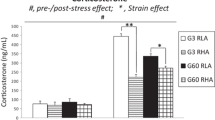Abstract
A recent claim that inbred sublines of the Roman high and low selection strains are not differentiated for avoidance performance casts doubt on the results of an earlier triple test-cross study using the lines. However, data from 220 litters of crosses to these lines demonstrate that the claim was certainly incorrect at the time of the earlier study, 1975–1977. The anomalous results which gave rise to the claim do not fit well with our knowledge of the genetic architecture of avoidance conditioning in rats; it is unlikely that inbreeding per se results in rapid acquisition of twoway active avoidance in Roman Low Avoidance rats.
Similar content being viewed by others
References
Broadhurst, P. L., and Bignami, G. (1965). Correlative effects of psychogenetic selection: A study of Roman high and low avoidance strains of rats.Behav. Res. Ther. 2:273–280.
Durcan, M. J. (1984). The current status of two sublines of the Roman High and Low Avoidance strains.Behav. Genet. 14:377–387.
Fulker, D. W. (1972). Applications of a simplified triple-test cross.Behav. Genet. 2:185–198.
Hewitt, J. K., and Broadhurst, P. L. (1983). Genetic architecture and the evolution of aggressive behavior. In Simmel, E., Hahn, M., and Walters, J. K. (eds.),Aggressive Behavior: Genetic and Neural Aspects, Lawrence Elbaumn, Hillsdale, N.J.
Hewitt, J. K., and Fulker, D. W. (1981). Using the triple test cross to investigate the genetics of behavior in wild populations. I. Methodological considerations.Behav. Genet. 11:23–36.
Hewitt, J. K., and Fulker, D. W. (1983). Using the triple test cross to investigate the genetics of behavior in wild populations. II. Escape-avoidance conditioning inRattus Norvegicus.Behav. Genet. 13:1–5.
Hewitt, J. K., and Fulker, D. W. (1984). Using the triple test cross to investigate the genetics of behavior in wild populations. III. Activity and reactivity.Behav. Genet. 14:125–135.
Hewitt, J. K., Fulker, D. W., and Broadhurst, P. L. (1981). Genetics of escape-avoidance conditioning in laboratory and wild populations of rats: A biometrical approach.Behav. Genet. 11:533–544.
Kearsey, M. J., and Jinks, J. L. (1968). A general method for detecting additive, dominance and epistatic variation for metrical traits. I. Theory.Heredity. 25:403–409.
Mather, K., and Jinks, J. L. (1982).Biometrical Genetics, 3rd ed., Chapman and Hall, London.
Wilcock, J., and Fulker, D. W. (1973). Avoidance learning in rats: Genetic evidence for two distinct behavioral processes in the shuttle box.J. Comp. Physiol. Psychol. 82:247–253.
Wilcock, J., Fulker, D. W., and Broadhurst, P. L. (1981). Analysis of two-way escapeavoidance conditioning measures from a diallel cross of eight strains of rats.Behav. Genet. 11:339–358.
van der Staay, F. J., Raaijmakers, W., and Kerbusch, S. (1983). Rapid acquisition of two-way active avoidance in inbred Roman Low Avoidance rats.Behav. Gent. 13:435–440.
Author information
Authors and Affiliations
Rights and permissions
About this article
Cite this article
Hewitt, J.K., Fulker, D.W. Genotypic differentiation of Roman selection lines did not “Disappear” with inbreeding. Behav Genet 14, 571–577 (1984). https://doi.org/10.1007/BF01068127
Received:
Accepted:
Issue Date:
DOI: https://doi.org/10.1007/BF01068127




